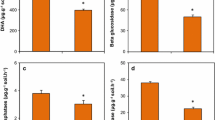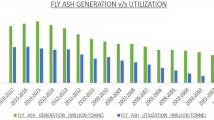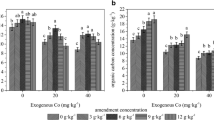Abstract
The present study aimed to investigate the variation in the metal(loid)s composition, phytochemicals, enzymatic and non-enzymatic antioxidants activity of pot marigold grown in different treatments of soil and fly ash (FA), i.e., control (soil 100% + 0% FA), 20% FA (soil 80% + 20% FA), 40% FA (soil 60% + 40% FA), 60% FA (soil 40% + 60% FA), 80% FA (soil 20% + 80% FA), and 100% FA (soil 0% + 100% FA). The plant leaves from each treatment were harvested and screened for various metal(loid)s concentrations (Fe, Cu, Mn, Ni, Co, Zn, Cd, Mg, Ca, and As). Further, the harvested leaf samples were extracted using three solvents (ethanol, methanol, and water), and their extract yield percentage, total flavonoid, and phenolic profile, total antioxidants (1,1-Diphenyl-2-picrylhydrazyl (DPPH) assay, ABTS (2,2’-Azinobis-(3-Ethylbenzthiazolin-6-Sulfonic Acid), Ferric reducing power assay (FRAP)), and antioxidant enzymatic activity (Superoxide dismutase (SOD), peroxidase (POD), ascorbate peroxidase (APX), and catalase (CAT)) were determined. The results revealed that a high accumulation of Fe, Cu, Ni, Co, Zn, and Cr with bioaccumulation factor (BAF > 1) was detected at 40% FA treatment. Furthermore, the phenolic and flavonoid content were increased by 35.44 and 160.13% respectively whereas, DPPH and ABTS activity (with low IC50) was decreased by 82.67 and 31.87% in ethanolic leaf extract at 60% FA application compared to the control. Additionally, at high FA application (100% FA), the parameters such as FRAP value, SOD, CAT, APX, and POD activity were increased by 42.42%, 313.98%, 388.76%, 415.11%, and 177.54% with respect to control soil. The findings suggested that FA application (up to 60%) in soil induced increased production of secondary metabolites, and total antioxidant activity compared to control soil.
Graphical Abstract







Similar content being viewed by others
References
Adnan M, Oh KK, Azad MOK, Shin MH, Wang MH, Cho DH (2020) Kenaf (Hibiscus cannabinus L.) leaves and seed as a potential source of the bioactive compounds: effects of various extraction solvents on biological properties. Life 10:223. https://doi.org/10.3390/life10100223
Afrousheh M, Shoor M, Tehranifar A, Safari VR (2015) Phytoremediation potential of copper contaminated soils in Calendula officinalis and effect of salicylic acid on the growth and copper toxicity. Int Lett Chem Phys Astron 50:159–68. https://doi.org/10.18052/www.scipress.com/ILCPA.50.159
Ahmad P, Ahanger MA, Alyemeni MN et al (2017) Exogenous application of nitric oxide modulates osmolyte metabolism, antioxidants, enzymes of ascorbate-glutathione cycle and promotes growth under cadmium stress in tomato. Protoplasma 255:79–93. https://doi.org/10.1007/s00709-017-1132-x
Ahmad G, Khan AA, Mohamed HI (2021) Impact of the low and high concentrations of fly ash amended soil on growth, physiological response, and yield of pumpkin (Cucurbita moschata Duch. Ex Poiret L.). Environ Sci Pollut Res 28:17068–17083. https://doi.org/10.1007/s11356-020-12029-8
Akhtar MS, Rafiullah M, Shehata WA, Hossain A, Ali M (2022) Comparative phytochemical, thin layer chromatographic profiling and antioxidant activity of extracts from some Indian herbal drugs. J Bioresour Bioprod 7(02):128–134. https://doi.org/10.1016/j.jobab.2022.01.001
Alvarenga P, Palma P, Mourinha C, Farto M, Dôres J, Patanita M et al (2017) Recycling organic wastes to agricultural land as a way to improve its quality: a field study to evaluate benefits and risks. Waste Manag 61:582–592. https://doi.org/10.1016/j.wasman.2017.01.004
Badiaa O, Yssaad HAR, Topcuoglu B (2020) Effect of heavy metals (copper and zinc) on proline, polyphenols, and flavonoids content of tomato (Lycopersicon esculentum Mill.). Plant Archives 20(1):2125–2137
Bedoya R, Cristina L, LÃpez G, MarÃn K, Nathalia P (2020) Extraction of metabolites from Calendula officinalis and evaluation of their colorant and antibacterial capacity. Revista Colombiana de BiotecnologÃa 22(1):60–69. https://doi.org/10.15446/rev.colomb.biote.v22n1.79999
Benslama A, Harrar A (2016) Free radicals scavenging activity and reducing the power of two Algerian Sahara medicinal plants extracts. Int J Herbal Medicine 4(6):158–161
Benzie IFF, Strain JJ (1999) Ferric reducing/antioxidant power assay: direct measure of total antioxidant activity of biological fluids and modified version for simultaneous measurement of total antioxidant power and ascorbic acid concentration. Methods Enzymol 299:15–23
Bisoi SS, Mishra SS, Barik J, Panda D (2017) Effects of different treatments of fly ash and mining soil on growth and antioxidant protection of Indian wild rice. Int J Phytorem 19(5):446–452
Bohara P, Dulta K, Chauhan P, Thakur K, Seth A, Chauhan PK (2020) Impact of different solvents on phytoconstituents, antioxidants, and FTIR analysis of Diplazium esculentum leaf extract from the Himalayan region. Plant Archives 20(2):6057–6063
Cakmak I, Marschner H (1992) Magnesium deficiency and highlight intensity enhance activities of superoxide dismutase, ascorbate peroxidase, and glutathione reductase in bean leaves. Plant Physiol 98:1222–1227. https://doi.org/10.1104/pp.98.4.1222
CEA (2020–2021) Report on fly ash generation at coal/lignite-based thermal power stations and its utilization in the country for the year 2020–2021. Central Electricity Authority, New Delhi, India
Chatoui K, Talbaoui A, Aneb M, Bakri Y, Harhar H, Tabyaoui M (2016) Phytochemical screening, antioxidant and antibacterial activity of Lepidium sativum seeds from Morocco. J Mater Environ Sci 7(8):2938–2946
Chen S, Wang Q, Lu H, Li L, Yang D, Liu J, Yan C (2019) Phenolic metabolism and related heavy metal tolerance mechanism in Kandelia obovata under Cd and Zn stress. Ecotoxicol Environ Saf 169:134–143. https://doi.org/10.1016/j.ecoenv.2018.11.004
Chhabra A, Velvijayan VB, Mohan S, Dahiya P (2021) Alteration in chemical composition and antioxidant defense potential of essential oil of Jatropha curcas L. grown in fly ash amended soil. Energy, Ecology, and Environment 6:566–575. https://doi.org/10.1007/s40974-021-00210-9
Dominic S, Hussain AJ, Saleem MH, Alshaya H, Jan BL, Ali S, Wang X (2022) Variation in the primary and secondary metabolites, antioxidant and antibacterial potential of tomatoes, grown in soil blended with different concentration of fly ash. Plants 11:551. https://doi.org/10.3390/plants11040551
Duman F, Ozturk F (2010) Nickel accumulation and its effect on biomass, protein content and antioxidative enzymes in roots and leaves of watercress (Nasturtium officinale R. Br.). J Environ Sci 22:526–532. https://doi.org/10.1016/S1001-0742(09)60137-6
Gajić G, Djurdjević L, Kostić O, Jarić S, Mitrović M, Pavlović P (2018) Ecological potential of plants for phytoremediation and eco restoration of fly ash deposits and mine wastes. Front Environ Sci 6:1–24. https://doi.org/10.3389/fenvs.2018.00124
Georgiadou EC, Kowalska E, Patla K, Kulbat K, Smolińska B, Leszczyńska J, Fotopoulos V (2018) Influence of heavy metals (Ni, Cu, and Zn) on nitro-oxidative stress responses, proteome regulation and allergen production in basil (Ocimum basilicum L.) plants. Front Plant Sci 9:862–876. https://doi.org/10.3389/fpls.2018.00862
Giannopolitis CN, Ries SK (1977) Superoxide dismutase: occurrence in higher plants. Plant Physiol 115:159–169. https://doi.org/10.1104/pp.59.2.309
Gjorgieva D, Kadifkova Panovska T, Ruskovska T, Bačeva K, Stafilov T (2013) Influence of heavy metal stress on antioxidant status and DNA damage in Urtica dioica. BioMed Res Int. https://doi.org/10.1155/2013/276417
Haddadi MA, Al-Dalain SY, Al-Tabbal JA, Bani-Hani NB, Jaradat DMM, Obeidat M, Al-Ramamneh EADA (2019) In vitro antioxidant activity, macronutrients and heavy metals in leaves of maize (Zea mays L.) plants grown at different levels of cattle manure amended soil in Jordan valley. Pak J Bot 51(3):933–940
Ibrahim MH, Kong YC, Mohd Zain NA (2017) Effect of cadmium and copper exposure on growth, secondary metabolites and antioxidant activity in the medicinal plant Sambung Nyawa (Gynura procumbens (Lour.) Merr). Molecules 22:1623. https://doi.org/10.3390/molecules22101623
Jambhulkar HP, Shaikh SMS, Kumar MS (2018) Fly ash toxicity, emerging issues and possible implications for its exploitation in agriculture; Indian scenario: a review. Chemosphere 213:333–344
Jiao H, Wang SY (2000) Correlation of antioxidant capacities to oxygen radical scavenging enzyme activities in blackberry. J Agric Food Chem 48(11):5672–5676
Kabata-Pendias A, Pendias H (2011) Trace elements in soils and plants, 4th edn. CRC Press, Boca Raton
Kar M, Mishra D (1976) Catalase, peroxidase, and polyphenol oxidase activities during rice leaf senescence. Plant Phys 57(2):315–319
Kaya C, Ashraf M, Alyemeni MN, Ahmad P (2019a) Responses of nitric oxide and hydrogen sulfide in regulating oxidative defence system in wheat plants grown under cadmium stress. Physiol Plant 168(2):345–360. https://doi.org/10.1111/ppl.13012
Kaya C, Okant M, Ugurlar F, Alyemeni MN, Ashraf M, Ahmad P (2019b) Melatonin-mediated nitric oxide improves tolerance to cadmium toxicity by reducing oxidative stress in wheat plants. Chemosphere 225:627–638. https://doi.org/10.1016/j.chemosphere.2019.03.026
Kerdsomboon K, Chumsawat W, Auesukaree C (2020) Effects of Moringa oleifera leaf extracts and its bioactive compound gallic acid on reducing toxicities of heavy metals and metalloid in Saccharomyces cerevisiae. Chemosphere 270:1–10. https://doi.org/10.1016/j.chemosphere.2020.128659
Kisa D, Elmastaş M, Öztürk L et al (2016) Responses of the phenolic compounds of Zea mays under heavy metal stress. Appl Biol Chem 59:813–820. https://doi.org/10.1007/s13765-016-0229-9
Kotelnikova AD, Rogova OB, Karpukhina EA, Solopov AB, Levin IS, Levkina VV, Proskurnin MA, Volkov DS (2022) Assessment of the structure, composition, and agrochemical properties of fly ash and ash-and slug waste from coal-fired thermal power plants for their possible use as soil ameliorants. J Clean Prod 333:1–15. https://doi.org/10.1016/j.jclepro.2021.130088
Kumar A, Gul MZ, Zeeshan A, Bimolata W, Qureshi IA, Ghazi IA (2013) Differential antioxidative responses of three different rice genotypes during bacterial blight infection. Aust J Crop Sci 7:1893–1900
Kumari A, Lal B, Pakade YB, Chand P (2011) Assessment of bioaccumulation of heavy metal by Pteris vittata L. growing in the vicinity of fly ash. Int J Phytoremed 13(8):779–787. https://doi.org/10.1080/15226514.2010.525561
Kuntal DAS, Someswar DEB, Karanth T (2019) Phytochemical screening and metallic ion content and its impact on the antipsoriasis activity of aqueous leaf extracts of Calendula officinalis and Phlebodium decumanum in an animal experiment model. Turk J Pharm Sci 16(3):292–302. https://doi.org/10.4274/tjps.galenos.2018.44265
Nakano Y, Asada K (1981) Hydrogen peroxide is scavenged by ascorbate-specific peroxidase in spinach chloroplasts. Plant Cell Physiol 22:867–880. https://doi.org/10.1093/oxfordjournals.pcp.a076232
Nile SH, Nile AS, Keum YS (2017) Total phenolics, antioxidant, antitumor, and enzyme inhibitory activity of Indian medicinal and aromatic plants extracted with different extraction methods. 3 Biotech 7(1):76. https://doi.org/10.1007/s13205-017-0706-9
Padhy RN, Nayak N, Dash-mohini RR, Rath S, Sahu RK (2016) Growth, metabolism, and yield of rice cultivated in soils amended with fly ash and cyanobacteria and metal loads in plant parts. Rice Sci 23(1):22–32
Panda D, Panda D, Padhan B, Biswas M (2018) Growth and physiological response of lemongrass (Cymbopogon citratus (D.C.) Stapf.) under different levels of fly ash-amended soil. Int J Phytoremediat 20(6):538–544. https://doi.org/10.1080/15226514.2017.1393394
Panda D, Mandal L, Barik J (2020a) Phytoremediation potential of naturally growing weed plants grown on fly ash amended soil for restoration of fly ash deposits. Int J Phytorem 22(1):1–9. https://doi.org/10.1080/15226514.2020.1754757
Panda D, Mandal L, Barik J, Padhan B, Bisoi SS (2020) Physiological response of metal tolerance and detoxification in castor (Ricinus communis L.) under fly ash-amended soil. Heliyon. https://doi.org/10.1016/j.heliyon.2020.e04567
Panda D, Barik JR, Barik J, Behera PK, Dash D (2021) Suitability of Brahmi (Bacopa monnieri L.) cultivation on fly ash-amended soil for better growth and oil content. Int J Phytoremediat 23(1):72–79. https://doi.org/10.1080/15226514.2020.1791052
Pandey SK, Bhattacharya T (2019) Mobility, ecological risk and change in surface morphology during sequential chemical extraction of heavy metals in fly ash: a case study. Environ Technol Innov 13:373–382
Pandey SK, Bhattacharya T, Chakraborty S (2016) Metal phytoremediation potential of naturally growing plants on fly ash dumpsite of Patratu thermal power station, Jharkhand. India Int J Phytoremed 18(1):87–93
Pramanick P, Chakraborty A, Raychaudhuri SS (2017) Phenotypic and biochemical alterations in relation to MT2 gene expression in Plantago ovata Forsk under zinc stress. Bio Metals 30(2):171–184. https://doi.org/10.1007/s10534-017-9990-4
Qadir SU, Raja V, Siddiqui WA, Alyemeni MN, Ahmad P (2020) Foliar concentrations of selected elements, assessment of oxidative stress markers and role of antioxidant defense system is associated with fly ash stress tolerance in Withania somnifera. J Plant Growth Regul 40(4):1450–1465. https://doi.org/10.1007/s00344-020-10200-6
Rajput VD, Harish SRK, Verma KK, Sharma L, Quiroz-Figueroa FR, Meena M, Gour VS, Minkina T, Sushkova S, Mandzhieva S (2021) Recent developments in enzymatic antioxidant defence mechanism in plants with special reference to abiotic stress. Biology (basel) 10(4):267. https://doi.org/10.3390/biology10040267
Randelovic D, Gajic G, Mutic J et al (2016) Ecological potential of Epilobium dodonaei Vill. for restoration of metalliferous mine wastes. Ecol Eng 95:800–810. https://doi.org/10.1016/j.ecoleng.2016.07.015
Re R, Pellegrini N, Proteggente A, Yang M, Rice-Evans C (1999) Antioxidant activity applying an improved ABTS radical cation decolorization assay. Free Radic Biol Med 26:1231–1237
Roghini R, Vijayalakshmi K (2018) Phytochemical screening, quantitative analysis of flavonoids and minerals in ethanolic extract of Citrus paradise. Int J Pharm Sci Res 9:4859–4864. https://doi.org/10.19080/JDVS.2019.09.555768
Saeed Z, Iqbal S, Younas U, Pervaiz M, Bukhari SM, Zaidi A (2020) Variation in the antioxidant potential of Vigna unguiculata grown in pure and amended soil. Kuwait J Sci 47:2–14
Saffari VR, Saffari M (2020) Effects of EDTA, citric acid, and tartaric acid application on growth, phytoremediation potential, and antioxidant response of Calendula officinalis L. in a cadmium-spiked calcareous soil. Int J Phytoremed. https://doi.org/10.1080/15226514.2020.1754758
Sagar R, Sahoo HB, Kar B, Mishra NK, Mohapatra R, Sarangi SP (2014) Pharmacological evaluation of Calendula officinalis L. on bronchial asthma in various experimental animals. Int J Nutr Pharmacol Neurol Dis 4:95–103. https://doi.org/10.4103/2231-0738.129595
Sakurai M, Tomioka R, Hokura A, Terada Y, Takenaka C (2019) Distributions of cadmium, zinc, and polyphenols in Gamblea innovans. Int J Phytorem 21(3):217–223. https://doi.org/10.1080/15226514.2018.1524840
Shakeel A, Khan AA, Hakeem KR (2020) Growth, biochemical, and antioxidant response of beetroot (Beta vulgaris L.) grown in fly ash amended soil. SN Appl Sci 2:1378. https://doi.org/10.1007/s42452-020-3191-4
Shakeel A, Khan AA, Alharby HF, Bamagoos AA, Tombuloglu H, Hakeem KR (2021) Evaluation of coal fly ash for modulating the plant growth, yield, and antioxidant properties of Daucus carota (L.): a sustainable approach to coal waste recycling. Sustainability 13:5116. https://doi.org/10.3390/su13095116
Singh JS, Pandey VC (2012) Fly ash application in nutrient poor agriculture soils: Impact on methanotrophs population dynamics and paddy yields. Ecotoxicol Environ Saf 89:43–51
Singleton VL, Rossi JA (1965) Colorimetry of total phenolics with phosphomolybdic-phosphotungstic acid reagents. Am J Enol Vitic 16:144–158
Sonter S, Mishra S, Dwivedi MK, Singh PK (2021) Chemical profiling, in vitro antioxidant, membrane stabilizing and antimicrobial properties of wild-growing Murraya paniculata from Amarkantak (M.P.). Scientific Reports. https://doi.org/10.1038/s41598-021-87404-7
Truong DH, Nguyen DH, Ta NTA, Bui AV, Do TH, Nguyen HC (2019) Evaluation of the use of different solvents for phytochemical constituents, antioxidants, and in vitro anti-inflammatory activities of Severinia buxifolia. J Food Qual. https://doi.org/10.1155/2019/8178294
Tungmunnithum D, Thongboonyou A, Pholboon A, Yangsabai A (2018) Flavonoids and other phenolic compounds from medicinal plants for pharmaceutical and medical aspects: an overview. Medicines 5(3):93. https://doi.org/10.3390/medicines5030093
Turumtay EA, İslamoğlu F, Çavuş D, Şahin H, Turumtay H, Vanholme B (2014) Correlation between phenolic compounds and antioxidant activity of Anzer tea (Thymus praecox Opiz subsp. caucasicus var. caucasicus). Ind Crop Prod 52:687–694
Upadhyay SK, Ahmed M, Srivastava AK, Abhilash PC, Sharma B (2021) Optimization of eco-friendly novel amendments for sustainable utilization of Fly ash based on growth performance, hormones, antioxidant, and heavy metal translocation in Chickpea (Cicer arietinum L.) plant. Chemosphere. https://doi.org/10.1016/j.chemosphere.2020.129216
Varshney A, Mohan S, Dahiya P (2020) Growth and antioxidant responses in plants induced by heavy metals present in fly ash. Energy Ecol Environ 6:92–110. https://doi.org/10.1007/s40974-020-00191-1
Varshney A, Mohan S, Dahiya P (2021) Assessment of leaf morphological characteristics, phenolic content, and metal(loid)s concentrations in Calendula officinalis L. grown on fly ash amended soil. Ind Crops Prod 174:1–9. https://doi.org/10.1016/j.indcrop.2021.114233
Wang S, Shi X, Sun H, Chen Y, Pan H, Yang X, Rafiq T (2014) Variations in metal tolerance and accumulation in three hydroponically cultivated varieties of Salix integra treated with lead. PLoS ONE 9:108–568
Yu CL, Deng Q, Jian S, Li J, Dzantor EK, Hui D (2019) Effects of fly ash application on plant biomass and element accumulations: a meta-analysis. Environ Pollut 250:137–142. https://doi.org/10.1016/j.envpol.2019.04.013
Zandalinas SI, Balfagón D, Arbona V, Gómez-cadenas A (2017) Modulation of antioxidant defense system is associated with combined drought and heat stress tolerance in citrus. Front Plant Sci Sci 8:1–10. https://doi.org/10.3389/fpls.2017.00953
Acknowledgements
The authors would like to thank Amity University Uttar Pradesh, Noida, for providing the facilities to carry out this work.
Funding
Financial support from the Council of Science and Technology (CST), Department of Science and Technology, UP, Government of India through the research grant (CST/AAS/D-1549) to Dr. Sumedha Mohan and Dr. Praveen Dahiya is gratefully acknowledged.
Author information
Authors and Affiliations
Contributions
AV: Experimental design, Writing- original draft and software, Data curation/PD: Conceptualization, Methodology, Project administration, Funding acquisition, Review, and Editing/SM: Conceptualization, Methodology, Project administration, Funding acquisition, Validation, Review and Editing.
Corresponding authors
Ethics declarations
Conflict of interest
The authors declare that they have no conflicts of interest in this work. We declare that we do not have any commercial or associative interest that represents a conflict of interest in connection with the work submitted.
Additional information
Handling Editor: Sudhir K. Sopory.
Publisher's Note
Springer Nature remains neutral with regard to jurisdictional claims in published maps and institutional affiliations.
Supplementary Information
Below is the link to the electronic supplementary material.
Rights and permissions
Springer Nature or its licensor (e.g. a society or other partner) holds exclusive rights to this article under a publishing agreement with the author(s) or other rightsholder(s); author self-archiving of the accepted manuscript version of this article is solely governed by the terms of such publishing agreement and applicable law.
About this article
Cite this article
Varshney, A., Dahiya, P. & Mohan, S. Antioxidant Activity of Pot Marigold (Calendula officinalis L.) in Response to Metal(loid) Induced Oxidative Stress from Fly Ash Amended Soil. J Plant Growth Regul 42, 5928–5944 (2023). https://doi.org/10.1007/s00344-023-10977-2
Received:
Accepted:
Published:
Issue Date:
DOI: https://doi.org/10.1007/s00344-023-10977-2




